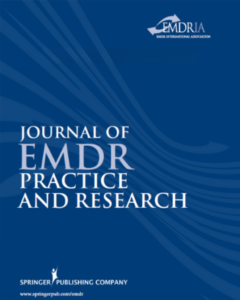The Effects of Bilateral Eye Movements on EEG Coherence When Recalling a Pleasant Memory (Journal of EMDR Practice and Research)
Participants were exposed to bilateral eye movements during the contemplation of a positive memory and measured with electroencephalographies.
Read MoreFacilitating access to emotions: Neural signature of EMDR stimulation (PLoS ONE)
This study examined whether there is increased activation of the amygdala during bilateral stimulation (BLS) in EMDR therapy.
Read MoreDissociation, EMDR, and adaptive information processing: The role of sensory awareness (Springer, 2014)
This chapter explores sensory awareness, EMDR, and adaptive information processing (AIP) for applications beyond PTSD, in this text focused on dissociation.
Read MoreDissociation de la personnalité et thérapie EMDR dans les troubles complexes liés au trauma : applications dans la phase de stabilisation (Journal of EMDR Practice and Research)
Comme un précédent article dans ce journal l’a déjà proposé, les cliniciens EMDR (désensibilisation et retraitement par les mouvements oculaires)…
Read MoreReducing anxiety and enhancing physical performance by using an advanced version of EMDR: A pilot study (Brain and Behavior)
The purpose of this paper was to investigate an advanced version of EMDR for the treatment of performance anxiety: the wingwave method.
Read MoreBilateral saccadic eye movements and tactile stimulation, but not auditory stimulation, enhance memory retrieval (Brain and Cognition)
Discussion of alternating bilateral activation of the left & right hemispheres and its effects on memory connectivity between the hemispheres.
Read MoreA Commentary on Hornsveld et al. (2011): A Valid Test of Resource Development and Installation? Absolutely Not (Journal of EMDR Practice and Research)
Evidence supporting “working memory” & “REM/Orienting Response” hypotheses as mechanisms of treatment effects of EMDR on patients with PTSD.
Read MoreStop the Use of Eye Movements in Resource Development and Installation, Until Their Additional Value Has Been Proven: A Rejoinder to Leeds and Korn (2012) (Journal of EMDR Practice and Research)
Response to Leeds & Korn, arguing study results are in line with mounting evidence supporting a working memory account for eye movements.
Read MoreHow does EMDR work? (Journal of Experimental Psychopathology)
Paper on the findings of a long series of experiments that disproved the hypothesis that eye movements or other ‘dual tasks’ are unnecessary.
Read MoreSuggestions pour l’enseignement de l’application des mouvements oculaires en EMDR (Journal of EMDR Practice and Research)
Les Questions & réponses cliniques. Question : « En tant que superviseur et animateur EMDR, j’observe souvent que les supervisés et les…
Read More



